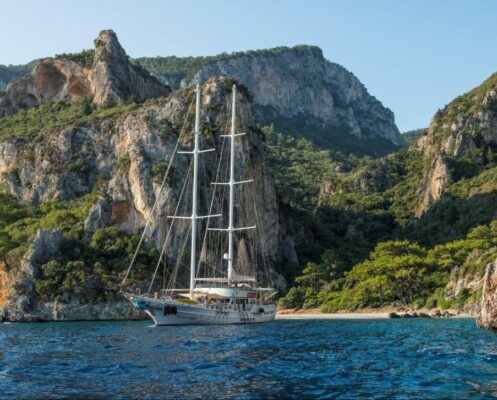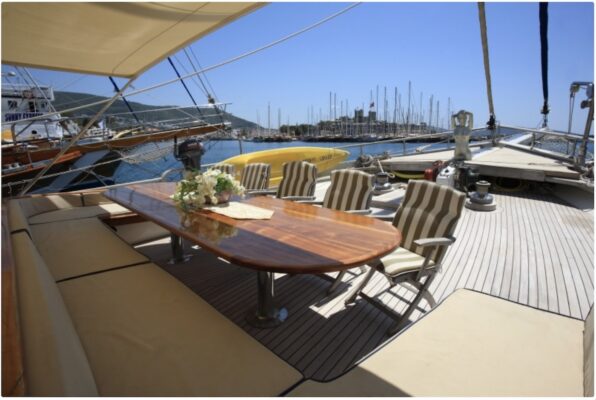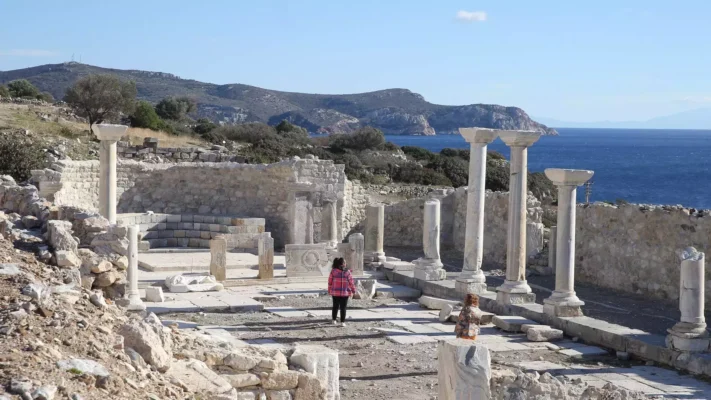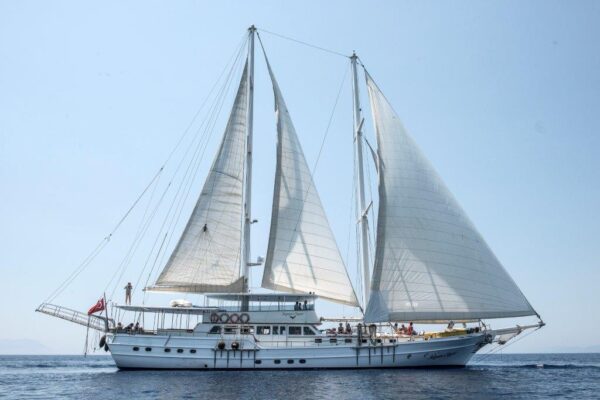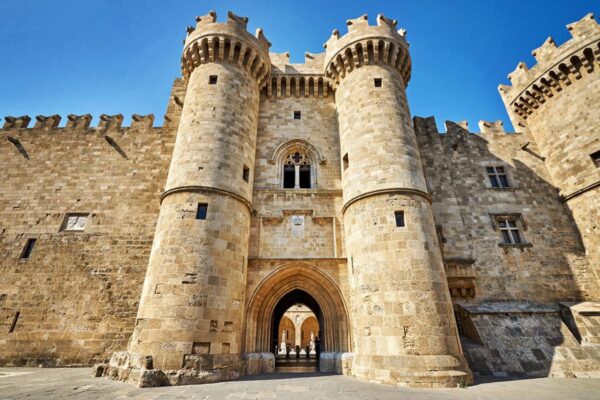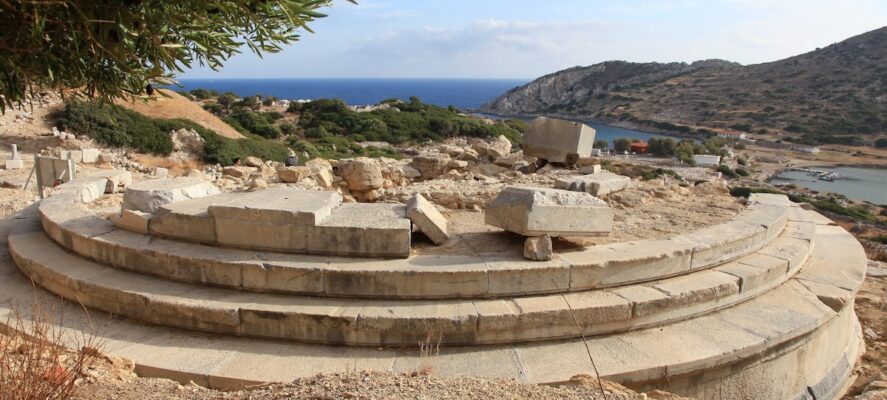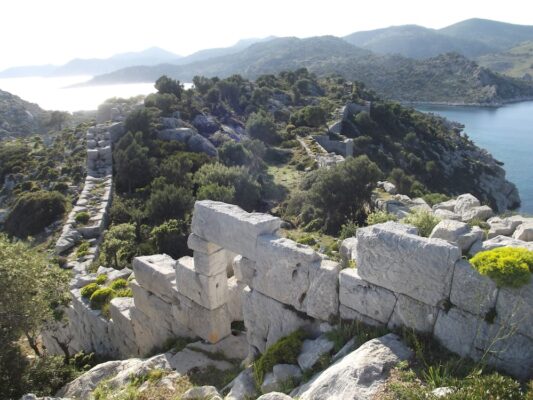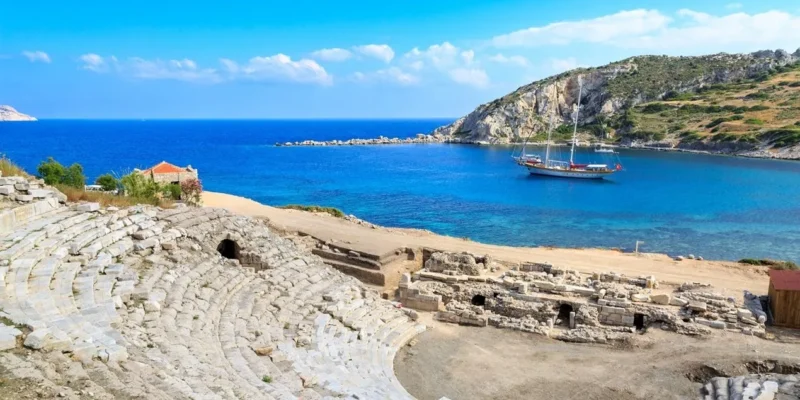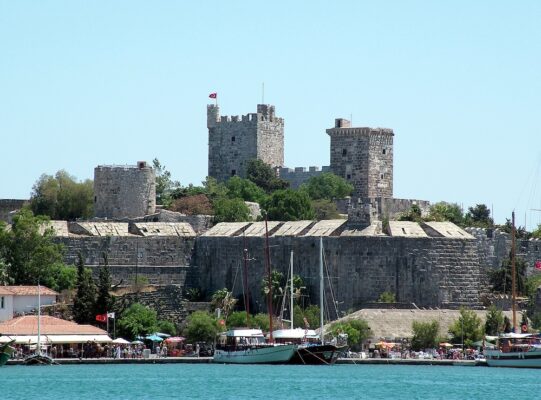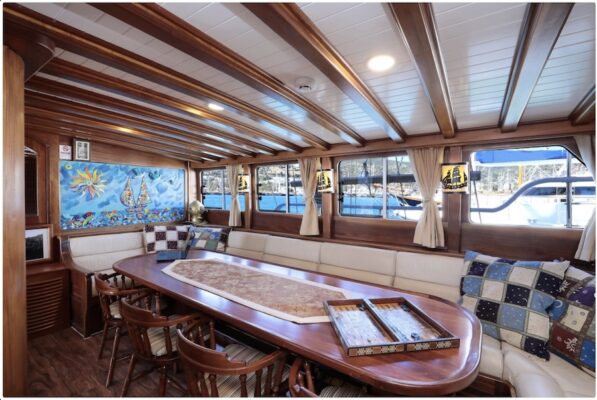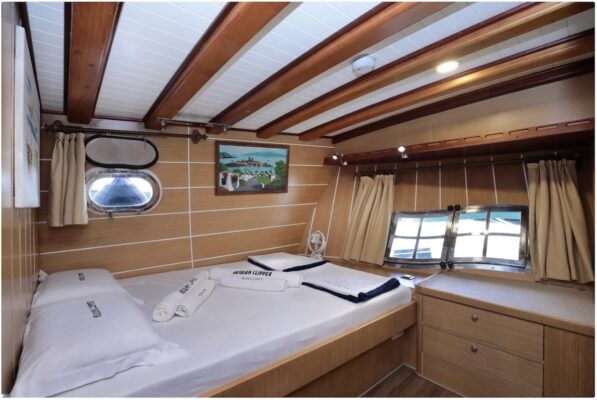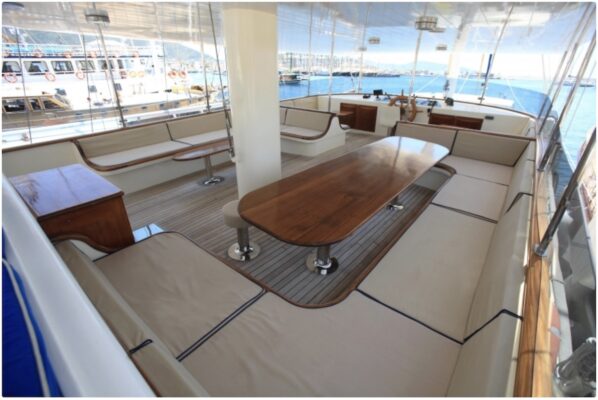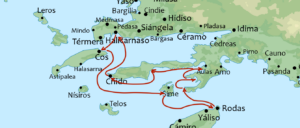Castles of Caria
Cruising the Turkish coast + Greek Islands (Kos, Symi, and Rhodes)
Cultural Program (maritime travel)
Ancient Greek archeology, Byzantine architecture, coastal towns, secluded bays, ancient Greek ampitheaters, castles of the Knights Hospitaller of the Order of St. John, swimming and snorkeling, gourmet eating and wine under the stars.
Sept 12th - 21st, 2025
Sept, 2026
Registration: WAIT LIST ONLY (Max 17 participants)
The Castles of Caria archeological and cruising tour will start and end in Bodrum, Turkiye, which is served by an international airport and a convenient point of departure for sailing vessels. Indeed, the port has proved vital throughout the millennia with remnants of past empires dotting its protected bay; the Halikarnassos Mausoleum (built around 350 BC) was considered one of the seven wonders of the world, while the Knights Hospitaller built a fantastic castle in the 15th century that still stands as a landmark of the city. After two days exploring Bodrum, we will embark on a private wooden ship called a gulet for our cruise through the islands and inlets of the famous “Turquoise coast”. The natural beauty of this coastline with its steep arid hillsides plunging into clear blue water is stunning. We visit the Greek islands of Kos, Symi, and Rhodes, and explore the hidden bays of the sparsely inhabited Bozburun and Datca peninsulas on the Turkish mainland. We take our meals on the boat provided by an expert chef, but explore sites on land during the day. Every anchorage offers the chance for refreshing swims in clear blue water, or a paddle on kayaks. Evening drinks on one of several spacious decks before evening meals under the stars. Many of our guests who have enjoyed our other tours will be thrilled at this opportunity. For new visitors to our company, please see our review page for a sense of what to expect.
Details:
- Arrive-Depart Bodrum (airport designation BJV).
- 10 day trip (2 nights Bodrum, 7 nights on private charter boat).
- Visas: US passport holders need to obtain an evisa.
- Maximum 17 guests (only a deposit secures a place on tour).
Tour Leaders:
- John Graham
- Invited specialists
Accommodation:
- Best available boutique hotels, gulet charter.
Brochure:
- Contact us for the invitational tour brochure and registration form. Email: admin@johngrahamtours.com
Registration:
- Submit registration form (sent at your request)
- Send deposit of $1500 to secure your place (details in registration form)
Fees (2025):
- Castles of Caria tour fees are detailed in the tour brochure. Please email us for a copy!
- Inquire about discounts for the Castles of Caria tour if you have been on a previous JohnGrahamTour!
Payment Methods:
- Bank transfer (preferred)
- Personal check to Vermont address
- Credit card via Paypal (3% Paypal charge applies)
Pre/Post-Tour Options
- While we are not offering extension trips ourselves, we recommend arriving a day early to Bodrum (airport transfers provided). After the tour, if you would like to continue independent travel, we recommend staying two more nights in Istanbul, which is a fascinating city that we will not have time to explore on our main itinerary.
Included:
- Accommodation in high quality boutique hotel in Bodrum, and cabins as described in the itinerary on the gulet charter.
- All ground transportation including airport transfers
- All meals with wine
- All entrances
- Guides
Not Included:
- International airfare
- Tips for primary guide and gulet crew
- Personal services (laundry)
- Personal bar tab on the gulet
- Travel insurance (required)
Mobility-Fitness:
- Standard: 3/10 on the mobility scale (10 being the most demanding).
- General fitness required. For some optional shore locations, we will need to scramble on rocky terrain to see the sites.
- While the boat is cruising, balance may be required when moving around the boat.
Special Notes:
- Architectural focus, historical focus
- Wine and cuisine
- Exceptional natural landscapes, as seen from the sea
- Swimming, kayaking, and water sports.
- Two countries with maritime border crossings (present passports at harbormaster's office)
Weather:
- We will expect hot weather on the Mediterranean in September. Prepare for temperatures between 70-85 F. We are unlikely to encounter rain. In the afternoon, the wind could pick up, so a long sleeve shirt or windbreaker might be desirable. The cabins will be warm, but we will have air conditioning.
Packing:
- There is limited space on the boat, so please pack light. Lightweight summer clothing is best.
- Comfortable walking shoes for shore excursions through towns and around ancient Greek archeology sites.
- Sunhats, sunscreen, sun-glasses, swimsuits, swimming goggles, etc.
- Summer pajamas (the cabins are warm, even with air conditioning).
Travel Program…
We are excited to welcome our guests to our new archeology and cruising program, "Castles of Caria!" We will travel aboard a gulet charter cruise for an adventure exploring the coastlines of Turkiye and the fascinating nearby Greek islands of Kos, Symi, and Rhodes This has been a maritime highway for millennia, with the shipwrecks, ancient cities, and ambiance to prove it!
It is impossible to see everything in one trip, yet this trip packs in a number of the significant sites while maintaining a decidedly leisurely pace. Daily cruising time never exceeds 4 hours per day. Some days we will be in ports exploring what is on offer on shore, while other days we will anchor in secluded bays enjoying the peace of the stars and the waves. With a fantastic chef and plenty of gourmet Turkish red wine on board, every evening will be a special night out under the stars.
September is the perfect time to cruise these coasts, as the water temperature is still warm enough to enjoy a swim at any time day or night, but the extreme temperatures of the summer have worn off. Still, the dramatic winds of the Aegean will not have arrived yet, and sailing should be relatively calm.
Our captain has 40 years experience sailing these waters, and this is his own private wooden ship. He and his crew of 4 keep the boat spotlessly clean, while also attending to our guest's every need. Come and relax with us, while we enter the world of ancient Greek maritime travelers.
The charter boat:
I toured a series of gulet charter boats in an effort to understand their quirks and nuances because life aboard a private gulet is a particular kind of experience that may not be for everyone, please allow me to describe. First of all, the cabins on all gulet boats are tiny (don’t be fooled by the photos), but the point to keep in mind is that no one spends any time in these cabins except to sleep; we will be outside on deck for the majority of our waking hours while onboard ship. So, I started looking for gulets with exceptional common spaces, but when imagining a group, I found them all a bit small and cramped. The standard-sized gulet features eight guest cabins which means a lot of people sharing limited common spaces. So, I started looking at larger boats, and almost immediately found the right one.
The boat is a double-masted ketch style gulet, measuring 135 feet long, skippered and owned by captain Ergun who has over 40 years’ experience sailing these coastlines (his grown children are also skippers in their own right!). I think it’s important that he skippers his own boat, so he knows every detail about its engine and water systems. Ergun also knows all the most favorable anchorages, whether we are at port or in a secluded bay. The boat features 11 cabins for potentially 22 guests (in addition to 5 crew) and features a variety of common spaces both shady and sunny, forward and aft, indoor and outdoor, and a very nice bar space. There are even some sunning cushions on the upper solar-panel deck which were placed specially, according to the captain, for French clients who insisted on nude sun-bathing. The point is, this boat has a lot of common space to find a conversation corner or a quiet corner. My plan is to limit our group to 17 people rather than fill the boat to capacity, thus giving us the luxury of even-more deck space.
The beds have good quality mattresses, and each cabin features a private bath/shower. The boat is older than others we saw (built in 2000) with less shiny trim, but the boat features solid teak cabin doors, a strong hull, classic portal windows, and Ergun spends his life either sailing or upgrading the boat. For example, while inspecting the boat in dry dock last week, he was in the process of repainting the hull and replacing every air-conditioning motor on the boat (each room has an individual air conditioner, which are especially needed for cruises in July and August). I found that the sleek new gulets are extremely over-priced for what one gets, which is essentially the same-sized cabins and the same amount of deck space. The newer boats feature jacuzzis on the deck, private television sets in each room, shiny metal/glass trim etc but for my eye, don’t justify double or triple the rental expense.
In summary, I’ve chosen the older, well-maintained boat at a reasonable cost, skippered by the owner himself, with extra deck space which I’ll further maximize by limiting our total group size.
Historical-Cultural view:
The “Cruising the Carian Coast” tour is so named because this region of southwestern Anatolia was once inhabited by the Carian people, attested in many ancient Greek sources. On this tour, we explore various layers of history of the region of Caria, including its bronze-era ancient seafaring past (1000-2000 BC), its Greek golden era (500-100 BC), churches from the Byzantine “late antique” period, and the prominent crusader fortresses left by the retreating Knights Hospitaller (St. John’s Order of the Knights of Malta). We also discuss the repercussions of the Greco-Turkish population exchange policy of 1922, which destroyed many multi-ethnic communities and led to the current unnatural maritime borders between the Greek islands and the Turkish mainland. On our tour, we show that these communities have always been part of a single maritime cultural zone that today is recreated, in a sense, by the advent of cross-border maritime cultural tourism.
Ancient Sites:
The jutting peninsulas that stretch into the Aegean Sea are precipitously mountainous, making travel by land nearly impossible even today and rendering many areas accessible only be sea. But this terrain also provided plentiful safe harbors for seafarers traveling from Egypt and Canaan to the Greek city states and beyond. The evidence for this vibrant trade route is discovered in one of the best underwater archeology museums in the world, housed in the historic fortress in Bodrum and one of our key destinations in the first days of our tour. Within this museum, we learn about the trade goods of sea merchants from as early as 1300 BC whose ships were wrecked on the Carian coast but have been recovered piece by piece using advanced diving equipment in the modern era.
The Carian people were a mainland tribe who had their own language and alphabet, but established trade and political ties with various Greek entities. For example, king Mausolus of Halikarnossos was a satrap of the Persian Achaemenid empire but hired Greek architects from Priene to build his magnificent burial chamber. The resulting structure gave the name “mausoleum” to all future extravagant tombs because of its immense structure and incredibly ornate carvings. Some of the blocks of this mausoleum were used in the construction of the harbor fortress by 15th century knights, while many of the carved statues and panels are housed in the British Museum. There is also an ancient Greek theater preserved in the hillside above the Bodrum bay, and various remnants of a large defensive wall structure from that period.
The Asclepieion of Kos was founded by Hippocrates in the 4th century BC as a center of medicine and healing. Though not much remains today, it is an important archeological site which we will try to visit, time permitting.
Time permitting, we will visit the ancient Greek city of Lindos on Rhodes, and we learn about the colossal statue of Helios at the entrance to the bay of Rhodes city built in 280 BC.
When we return across the narrow straight to the mainland, we will hike up to the remains of the ancient settlement of Loryma, from whose vantage point all of the surrounding islands are clearly visible.
On the last day of the trip, we explore the city of Knidos, one of the archeological highlights of the tour. This high antiquity city was the center of the confederation of states called the Dorian Hexapolis in the 4th century BC. With its sandy isthmus between rocky shore and island, it was famous for two protected bays at opposite points of the wind. Thus, ancient seafarers awaiting favorable winds would often stay for many days worshipping at the city’s major shrine dedicated to Aphrodite, and reputedly visiting the city’s equally famous porneio. Today, the hillside is littered with the remains of hundreds of buildings and marble shrines, making it easy to imagine an incredible city with sea views in every direction. A theater and agora dominate the lower structures along the shore, while the shrine sites are situated further up the slope.
Byzantine sites:
On this itinerary, we encounter a few Byzantine era churches. On the Greek island of Kos, a 4th century baptistry with seven altars inside is considered one of the oldest intact Christian baptistries anywhere in the world. On the island of Symi, the monastery of St. Michael’s features 15th century Byzantine-style frescoes while an adjacent museum displays precious manuscripts and religious objects mostly from the 15th-18th century period.
On Rhodes, the the 11th century church known as “Our Lady of the Castle” is the largest surviving Byzantine church on the island. It has an interesting architectural history: after an earthquake in 1303, the Catholic Church supported its reconstruction in the later 14th century. After battle damage in 1480, the Knights Hospitaller also rebuilt the church. In the 16th century, it was converted into a mosque. The Italians removed the minaret in the 20th century, converting the space back into a Byzantine-Catholic church. Some frescoes from the 14th century remain.
The Philerimos monastery was built by the Knights Hospitaller in the 15th century to house the 12th c. icon of the Virgin Mary which was considered the protectress of the order. Rebuilt in the 20th century by the Italians, the site is worth the short 10-mile drive if guests want to arrange a private visit during our day in Rhodes.
Castles:
The Knights Hospitaller were founded in Jerusalem after the First Crusade in 1099 to protect sick and wounded pilgrims. Between 1310-1522 the religious-military order was based in Rhodes where they controlled maritime trade between the islands and the mainland through the construction of castles and the maintenance of active diplomatic and trade ties with other regional powers. The knights were industrious builders, leaving behind formidable structures such as the Petronium Castle in Bodrum, the Nerantzia castle in Kos, and the castle and old city of Rhodes. As the order was multi-national and multi-lingual, the heraldry of each ‘national’ branch of the order are displayed prominently in the walls of these fortresses.
Request the full brochure! Email: admin@johngrahamtours.com
Tour Locations:
Bodrum
+ In Bodrum, where we start and end our tour, we visit the Halikarnassos mausoleum ruins, one of the seven wonders of the ancient world. We also visit the impressive 15th castle of the Knights Hospitaller, which also houses the world famous museum of Underwater Archeology. Each tower in the castle is a museum exhibit featuring one or more ancient shipwrecks that have been meticulously excavated from the nearby seabed. The finds are absolutely extraordinary!
Kos (Greek island)
+ We obtain our Greek entry stamps at the harbor-master's office in Kos, then spend a half-day exploring the old city including it's fortress, a 5th century Byzantine baptistry, and more!
Symi (Greek island)
+ Optional trip ashore to explore the old town at Panormitis, including the late-Byzantine monastery of St. Michael.
Rhodes (Greek island)
+ The largest of the islands in the Dodecanese archipelago, Rhodes is famous for its colossal statue of Helios, its ancient Greek cities at Lindos and elsewhere, and the 14th century fortress and old town that now dominate the port of Rhodes.
Carian coast of Turkiye
+ We will visit the remnants of the Ancient Greek city of Loryma above the Bozukkale bay, then enjoy exploring the intricate coastline of secluded bays and inlets. We will visit small artist towns like Bozburun and Selimiye and Datca, and on the last day, spend a significant time touring the well-preserved double-harbor ancient Greek city of Knidos.
Request the full brochure! Email: admin@johngrahamtours.com
